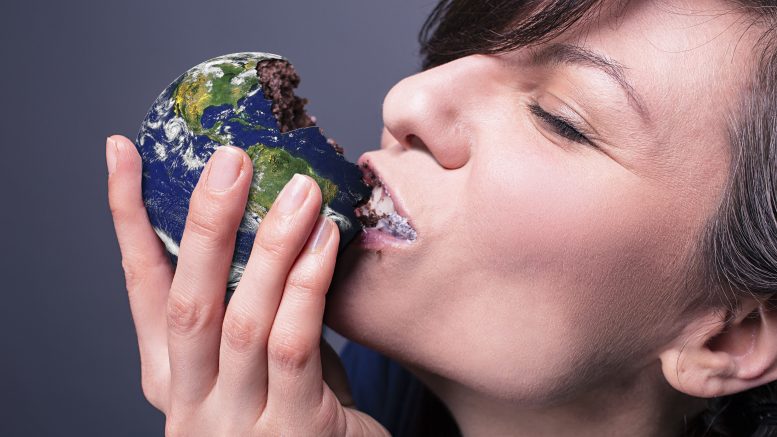We originally published this story back in the summer of 2022. Fast forward only six months, and just recently, we experienced a Connecticut farm fire in which an estimated 100,000 hens died. It’s one of several fires over the past decade that has resulted in millions of dead chickens. Add to that the chickens that are being culled and killed in the name of avian flu, and we have a crisis on our hands. Last summer, people were saying all this was just another conspiracy theory. But the fires keep happening. Tucker Carlson thinks it’s an issue; here is his commentary. He includes all the reports by farmers that chicken feed is being tainted. Hens are not laying eggs. Yes, hens have a dormant period, but it usually doesn’t last 6 or 7 months. Farmers have switched from certain commercial feeds to their own homemade feeds or even goat feeds and the hens start laying again. The targeting of poultry farms not only reduces the availability of chicken meat, but also eggs for consumption. Let’s not forget that eggs are used extensively in the production of traditional vaccines, but not mRNA vaccines. Is this a way to further advance mRNA technology?
Here’s the original story. It’s looooong, but that’s because there have been so many incidents. You decide whether it’s a conspiracy theory after you read it.
For a while now, Joe Biden has been saying that a real food shortage is coming. Not surprisingly, Biden and his minions are blaming it on Russia, stating that Vladimir Putin’s war on Ukraine is preventing Ukraine from exporting its fertilizer, which will have an impact on the world. Somehow, Biden’s prior press secretary Jen Psaki has downplayed comments from her boss, saying that America will be spared; while there will not be a food shortage here in America, the higher fertilizer costs will impact food supplies around the world.
Russia and Ukraine collectively export about 25 percent of the world’s wheat, as well as many other foods. These exports have been upended by the war, but once again, America will be spared, as Biden urges farmers to increase the US wheat supply to offset the shortages from Russia and Ukraine. Mainstream media falls right into lockstep with this administration, reminding folks that everything is hunky dory and urging them not to worry.
Are Biden and Psaki telling the truth? Will America really be spared, or is there something more nefarious going on here at home?
While many Americans do suffer from food insecurity, widespread nationwide food shortages are unfamiliar to most Americans because it has been nearly 100 years since the last food shortage during the 1930s Great Depression. For a while now, both farmers and truckers have been trying to warn the American people about the looming food crisis. They’re right – disturbing signs do exist. Most likely, you are noticing some semi-empty to completely empty shelves at your local grocery store.
Of course, the Deep State has been reprimanding us for years that climate change is causing a food crisis and it is all our fault. COVID-19 shutdowns have also definitely been the catalyst for the supply chain issues. Just three months into the pandemic, officials were warning us about the looming and inevitable food crisis. Different parts of the world have been affected differently, creating bottlenecks and other issues. Many parts and components come from Chinese plants that were shut down during COVID. It can take several months to start up production again. Because the COVID-19 crisis has lingered for over two years, production of goods has been greatly reduced in most of our major industries. Once those goods are finally produced, they must be delivered by planes, ships and trucks, but there are not enough workers to meet the demand.
Daily, 70 ships are on hold in the Long Beach and Los Angeles ports because of the lack of dock workers to handle the unloading. America is short about 80,000 truck drivers, and that number is growing due to jab mandates, retirements and other personal factors. Freight costs are also 10X what they were pre-pandemic and are continuing to rise.
The Fertilizer Shortage
Farmers worldwide are reducing use of chemical fertilizers, due to supply shortages and high costs. Many agricultural experts are concerned that crop yields will be affected come harvest time.
Brazil’s largest farmer, SLC Agricola SA, farms corn, soybeans, and cotton on a land mass larger than the state of Delaware and is reducing its fertilizer use by 25 percent amid soaring prices. The CEO of the company stated that reduction in fertilizer for this year will not affect near-term harvests because there is reserve fertilizer in the soil. However, other experts are concerned given that 80 percent of Brazil’s farmland relies on chemical fertilizers to produce coffee, sugar, maize, edible beans, wheat, and more. Commodity traders say that the fertilizer shortage will remain an issue for several years. Given that Brazil relies on imported fertilizer for 85 percent of its usage, this is a major issue that will affect food supplies for the whole world. This shortage affects not only Brazil, but all of the world’s top food producers, so Jen Psaki is likely wrong (as she is on so very many occasions) when she says the US will not be affected.
The Ethanol Decision
Biden recently lifted restrictions on selling a higher ethanol content gasoline during the summer months. This is normally prohibited, but Biden said he wanted to help Americans with price relief of 10 cents per gallon. Biden made great fanfare of the announcement, traveling to corn-rich Iowa to get in front of the press to announce the Environmental Protection Agency emergency waiver.
But does it help?
First a higher percentage ethanol in the gas mix actually lowers gas mileage, so Americans will not realize any cost benefit. Ethanol can also cause great harm of gas-fueled internal combustion engines.
Consider that more farmers will now be using their corn crops for ethanol rather than for food, thus increasing food shortages of sweet corn and feed corn used for livestock. Corn on the cob may not be available for your July 4 picnic, and meat prices will soar even higher because of the feed corn shortage. Making this ethanol decision while the country faces a food shortage seems unwise at this juncture, but lest we forget, America will not be affected, right? Even funnier is that the ethanol is traditionally not sold between June 1 and September 15 because the gas blend contributes to smog in higher temperatures. So much for the climate change agenda.
Fires at Food Plants
Can you remember the last time you heard about a fire in a food processing facility? Me neither, but recently there have been many incidents – over 50 incidents actually. It hardly seems coincidental, particularly given that the fires are occurring in an environment of soaring prices and stressed supply chains. These fires are occurring nationwide and have been happening since the summer of 2021, but you would never know it, thanks to the mainstream medias’ lack of honest reporting. In Kansas, a Tyson Foods meat processing plant caused closure of the location; it supplies about six percent of all US beef. A fire at Nebraska’s meat processing JBS USA facility threatened about five percent of the US beef supply chain. Fires also occurred in Arkansas and Maine at two major potato processing plants.
The trend continues in 2022 with a fire in Oregon at the Azure Standard headquarters, the nation’s largest manufacturer of organic, healthy food. Two days after the Azure fire, a small plane crashed into the General Mills plant in Covington, Georgia. In March, a huge fire wiped out an Indiana Walmart fulfillment center. In April, a fire at the East Conway Beef and Pork Company in New Hampshire was so large it took firefighters 16 hours to extinguish the fire.
Yet another fire occurred on April 30 at a Perdue plant in Virginia. Firemen quickly extinguished the fire in a large soybean processing tank; there were no injuries and the fire had little impact on the plant’s operations. Over Memorial Day weekend, an overnight fire destroyed a barn that housed tens of thousands of chickens at the Forsman Farm in Minnesota. The company is one of the nation’s largest egg producers, providing more than three million eggs to US’ largest retailers. While the cause of the fire remains a mystery, authorities are quick to point out that it was likely accidental. At least 200,000 chickens perished in the flames and the property suffered extensive damage, but no lives were lost. See the total list below, courtesy of SGTnewsNetwork.
In June 2022 alone, there were seven major US food facility fires, and the fires are happening in other countries as well, such as the complete destruction of a sausage factory in the UK. Ten crews from both Essex and Hertfordshire were required to battle the blaze.
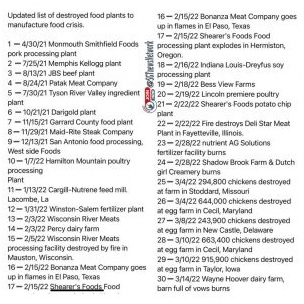
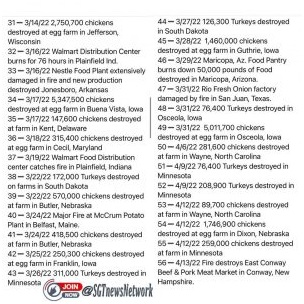
The War on Poultry and Pigs
There also seems to be a war on poultry, but never fear, the CDC is on the case. The CDC explains that although the highly pathogenic H5N1 avian influenza virus has been detected in 14 states, human infection risk is low. H5N1 first appeared in 1996 in southern China and has popped up every so often, once in 2003, then again in 2015. The virus began emerging once again in the US in 2021.
In Iowa, millions of birds have been destroyed in commercial poultry facilities. In March alone, the state suffered nine outbreaks, and to date, 8.2 million birds have been killed just in Iowa in an attempt to curb the virus. Approximately five million of those birds were laying hens at an egg facility. The state is the nation’s largest producer of eggs and sixth-largest producer of turkeys. Nationwide, well over 16 million birds have been destroyed. That amounts to a lot of drumsticks for dinner. The US Department of Agriculture has ordered all birds in any infected facility to be destroyed within 24 hours. The hypothesis is that wild birds migrating into the area are spreading the disease.
To date, 27 million chickens and turkeys have been killed, all in the name of consumer safety. The war on poultry may be worldwide. A fire in the Dutch town of Heusden burned 43,000 chickens in a commercial facility.
There also seems to be an emerging war on pigs. New South Wales is reporting an outbreak of Japanese encephalitis in piggeries. The mosquito-borne virus is quite common in other parts of the world but has never been spotted as far south as Australia. To date, about 30 pig facilities have been affected, leading to projected pork supply production losses of up to 80 percent. A few people have been infected and some have died, according to the Australian government. If sows are bitten, the gestation cycle and litter of piglets is affected, with many born with abnormalities and even more stillborn. Of course, there is a new pig vaccine in development to combat the problem.
Paying Farmers Not To Farm
Less food is grown because the Biden administration is paying farmers more money not to farm. Once again, for the noble effort of climate change, this administration wants to add 4 million acres of farmland to the Conservation Reserve Program (CRP), part of the US Department of Agriculture. Yes, this is another federal program that most of us have never heard of, even though it’s been around since 1985. Its mission is clear: the CRP takes land out of agricultural production to lessen environmental impact to cut greenhouse emissions in half by 2030 (or is that Agenda 2030?) When fallow land is plowed, it apparently releases an “alarming” amount of carbon dioxide into the atmosphere.
Farmers are paid incentives to take their land out of production, and incredibly, the US government rents the farmland from the landowners in 10-year leases. So far, the government rents 21 million acres nationwide. CRP proponents say the program only takes land out of farming for 10 years at a time, and the 25 million acres are just a fraction of the total land farmed. CRP spends about $300 million annually on the program. Secretary Tom Vilsack stated, “sometimes the best solutions are right in front of you.” Indeed.
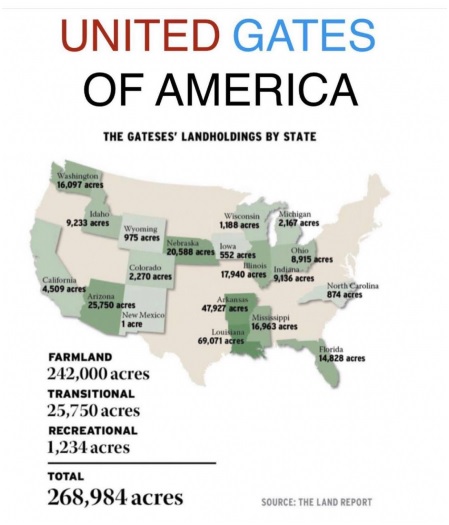 Farmland Purchases and Takeovers
Farmland Purchases and Takeovers
Owning another “tiny fraction” of land is none other than Bill Gates. With his purchases of 250,000 acres of farmland, Gates is the largest private owner of farmland in the country. He owns land in 18 states, with large holdings in Louisiana, Arkansas, and Nebraska, held through third party entities by Cascade Investments.
In his most recent nefarious move, Gates purchased over 2,000 acres of North Dakota potato farmland, close to both Minnesota and Canadian borders. Gates purchased the land through Texas-based Red River Trust, which Gates controls. North Dakota Agriculture Commissioner Doug Goehring got many calls from local residents who were absolutely livid and who questioned the legality of the purchase by a corporate entity. State Attorney General Drew Wrigley looked into the purchase but noted that it is legal and does comply with a state law that dates back to the Depression era and that is meant to protect family farms by leasing the land back to the farmers. On an interesting note, North Dakota Governor Doug Burgum sold his software company to Microsoft in 2001 and served as senior vice president at Microsoft through 2007.
Gates isn’t the only billionaire landowner; John Malone, the chair of Liberty Media and recent buyer of CNN owns 2.2 million acres of ranches and forests. However, Gates is the only landowner that is aggressively pushing genetically engineered crops on most of the developing world. Most disturbing of all is the foreign investment in American farms. Investors with communist party ties in China have purchased nearly as much land as Bill Gates, culminating in a concerted effort over the last decade to purchase not only farmland but agricultural businesses like Smithfield Foods, the nation’s largest pork processing company. Furthermore, there is an alarming trend regarding the Chinese buyers having connections to the Chinese Communist Party. Granted, there are 900 million acres of American farmland. China owns a small portion, but should America really allow China any access and control of our food supply? Other countries own US land, too. In fact, by the end of 2019, foreign entities owned more than 35 million acres, a land area bigger than the state of New York, and each year, investors buy 2.5 million more acres.
The Dutch government is forcing farmers to turn over their farms and kill livestock in order to reduce greenhouse emissions by 30 percent. The original proposal from September 2021 is ramping up, and farmers have taken to the streets in protest. They’re not backing down because their livelihoods — and their lives — are truly at stake. The Dutch nation is home to over 100 million cattle, swine, and chickens, and at the same time the government has granted 60 million Euro to the lab-grown meat industry.
The Weather
North Dakota is wheat growing country. The state is the top US grower of spring wheat, but heavy rains have prevented farmers from planting as much wheat crop this year. Farmers all across the state are expected to plant the smallest land area on historical record. One farmer mentioned that because of the soggy conditions, he had to abandon planting on a whopping 75 percent of the land he is used to seeding. Given that the US is the fourth largest exporter of wheat in the world, this creates a huge problem. China and Europe are experiencing bad harvests as well, and India has banned exports of its wheat to conserve for its own people. The US government is apparently asking US farmers to plan to seed more winter wheat this fall and has even considered planting on environmentally-sensitive lands. But winter wheat was also a problem as Kansas, the top winter wheat state, experienced severe drought that decimated the last winter crop, reducing the yield by 25 percent.
Food Recalls
On May 20, the FDA and CDC began investigating a “salmonella outbreak in several states.” The FDA compared the 2022 sample to one collected at the same plant in 2010, and it was a match. Interestingly, the FDA’s own website says they made the decision based on epidemiological evidence, but it also says that as of May 27, they only interviewed 5 people who had eaten the peanut butter. (Five sick people in multiple states hardly meets the criteria for “epidemiological.”) Subsequently, the J.M. Smucker Company voluntarily recalled certain lots of JIF brand peanut butter products produced in Lexington, Kentucky. The FDA has also posted 13 additional product recalls for products that incorporate the peanut butter.
FDA has posted a list of additional recalls being conducted by companies that have used the recalled Jif peanut butter as an ingredient in the manufacturing of a new product (e.g., chocolate products) or in repackaging the product (e.g., snack cups). This list will be updated as the agency receives notification of new recalls.
Cows Swooning in the Heat
Thousands of cattle have suddenly died in Kansas. The culprit? The heatwave. Cows are actually fairly resilient in the heat, but they do not adjust well to extreme variations in temperature and are especially susceptible to high heat for prolonged periods. However, a mass event is fairly rare. More than likely, there might be one or two young, old or sick cows that can’t stand up to the heat, but a mass dropping of cattle is unheard of. Oh, but the mainstream media says it is not only the heat, but also the humidity and a lack of wind. Many expert cattle ranchers are seriously doubting that these cows would drop dead all at one time. Rancher verdict? Something nefarious is going on.
Water Shortages
Lake Mead is perhaps the best example of impending water shortages during this long, hot summer. The lake is situated on the border between Nevada and Arizona, and is at an all-time historical low, so low in fact that a WWII-era Higgins boat was just discovered in the mud left by the receding water. This is significant because Lake Mead is the largest lake in the US; it was originally formed by the Hoover Dam on the Colorado River and it supplies drinking water and farm irrigation to 20 million people in California, Arizona, Nevada, and part of Mexico. Water levels are near “dead pool” levels, meaning water is so low that it won’t be able to generate power at the Hoover Dam. But dead pool has more than one meaning; many human remains are now being found in the lake, never seen before the low, low levels. The water shortage first occurred in August 2021 and is expected to be an issue through next summer, July 2023. Of course, climate change and drought is the cause. Again, it is all our fault. But keep in mind that this lake water is tied to farming. Rather than find a way to fill up the lake, farmers are being asked by the US Bureau of Reclamation Commissioner (yet another federal government agency) to reduce water usage by “4 million acre-feet of water — more than Arizona and Nevada’s share combined.”
Any one of these news items above, by itself, may not be alarming. We all tend to hear these things in small blips, or maybe we don’t hear about them at all. When all of these are considered together, it is quite alarming. Do all of these explanations factor into one overarching plan? Are they trying to create a food shortage? You be the judge. All things certainly seem to point in that direction!
++++++++++++++++++++++++++++++++
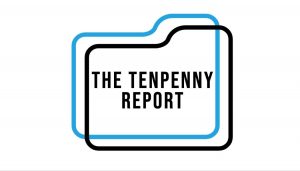 Like what you’re reading on The Tenpenny Report? Share this article with your friends. Help us grow.
Like what you’re reading on The Tenpenny Report? Share this article with your friends. Help us grow.
Join our list here
++++++++++++++++++++++++++++++++
Fed Up Texas Chick is a contributing writer for The Tenpenny Report. She’s a rocket scientist turned writer, having worked in the space program for many years. She is a seasoned medical writer and researcher who is fighting for medical freedom for all of us through her work.

